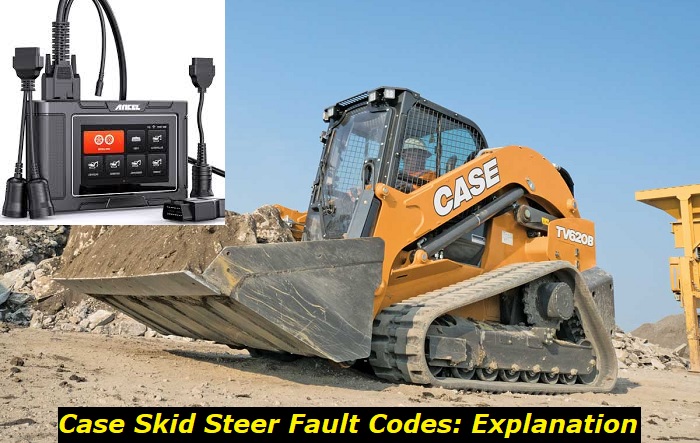Case Skid Steer Fault Codes: Reading, Understanding, and Fixing
Case skid steers have potential trouble hotspots and conditions that may slow down their overall output ability. While it may not be practical to keep track of all functionalities of the skid engine and appendages, computerized analysis of the machine operations is carried out continuously in real-time.
The modern construction machinery is equipped, like all other modern vehicles, with an onboard diagnostics system that is geared towards detecting any system malfunctions and alerts the operator for action. The Case Skid Steers are no different. They come equipped with an onboard system that scans all functional parts of the loader to detect faults that may inhibit proper operations of the loader.

In this article, we shall look at an in-depth analysis of how the diagnostic system works, how to interpret and understand the fault codes generated, and how to clear them from the system.
OBD and DTC
An OBD, or on-board diagnostic system is an on-board computer fitted in the skid steer (and other machinery) to monitor the performance of the engine and all other related functions of the skid steer machine. The OBD scans all the functionalities of the engine, the gearbox, control console, lifting procedures, temperatures, engine emissions, and any other related function.
When the OBD detects any error, failure, or malfunction, it transmits an alert on the dashboard or on the control console in form of a warning light for the operator to act. The warning light is intended to alert you to a possible fault in one of the operational components of the skid steer that may require your attention. Apart from the general dashboard/console warning, the system releases a unique fault code called the DTC.
The DTC, Diagnostics Trouble Code is a specific code that is unique to the identified fault. The OBD assigns a specific unique code for each identified problem and each code is stored in the OBD system as a reference number. Different codes have different meanings that represent each specific problem identified in the skid steer.
The DTC can only be accessed by connecting a scanner or diagnostic tool in the OBD socket to display the codes. However, the OBD can be configured to send the DTC alert directly to a specific gadget outside of the machine. For instance, in skid steers connected to fleet management telematics, the DTC can be transmitted directly in real time to the maintenance manager for immediate action.
Accessing the Fault Codes/DTC
You need to connect a diagnostic tool to the OBD system through the OBD socket located somewhere in the cabin. Once you locate the port, plug in the diagnostics scanner. It is important to note that some scanners have universal ports while others require adapters to plug into the port. After plugging in, turn the ignition to the "ON" position to provide power to the OBD and the scanner and allow them to communicate.
The scanner will display all the codes, including fault codes stored by the OBD system. Follow the onboard instructions on the scanner to read and record all the fault codes returned by the OBD system.
What are Fault Codes?
A fault code, technically called a DTC is a four or five-digit code that identifies a specific problem in your machine operations. These codes could be a letter followed by numbers (for example P4321), or just a combination of numbers (for example 12345). The codes could be aligned to a specific fault or a generic issue related to the machine type, manufacturer, or emission controls.
Fault Codes Categories
The fault/DTC codes can be classified into two general categories or types.
- Critical Codes - these are fault codes that point to a critical error or malfunction that lead to immediate severe damage to the engine or other critical components. Such faults require immediate and appropriate action to avert an apparent costly failure in your machine.
- No-Critical Codes- these are codes that point to non-critical issues which may not require immediate attention, but which still need proper attention within a specific period. Such faults could be related to emissions and other important operational areas.
The DTC codes are formulated to help the operator understand what requires to be fixed to keep the skid steer operating optimally and safely. Although the fault code does not give you a 100 percent specific area that needs to be fixed, it directs you to the specific area that requires to be tested to get the specific fault.
The OBD uses the diagnostic service codes system to relay information to the operators on potential faults or malfunctions that may have occurred in the machine in the process of its operations. The codes are generated when special machine controllers and sensors detect conditions that go beyond acceptable parameters
Understanding the Fault Codes
Fault codes generated by the OBD are just that, codes. They require further reading and interpretation to give the actual part or area to check or troubleshoot. For your information, the DTC may generate thousands of codes that are meaningless unless interpreted correctly.
The best place to refer is your machine manual or handbook which shows what each code refers to. Alternatively, you could check online for an interpretation of these codes. Remember to check for the most up-to-date code which is specific to your machine type and series.
The fault codes provide technical information that when decoded, gives the location, the faulty information, and the affected part or product.
This information must be retrieved by searching and aligning each code with its specific decoded message from the manual, user handbook, or online.
The numbers and/or digits on each code refer to a specific area. Generally, the first digit refers to a specific common area for example '1' may stand for Engine, power train, or chassis depending on the machine. The second digit refers to a general or specific issue while the other digits describe the fault.
The location (first digit) shows the component or the function on the machine that has been diagnosed by the OBD and which the code will describe, for instance, 'engine'.
The information type (second digit) refers to the technical information for that particular function or component, say 'coolant temperature'.
The other digits refer to the product-specific information that has been gathered by the OBD concerning its current status.
Upon checking each code against the code-specific details, one can get technical specifications, functional data, and diagnostic troubleshooting data for all the mechanical, hydraulic, and electrical components/devices, and assemblies.
For instance, a typical DTC/Fault code for a Case Skid Steer may look like this: 12110. This code when decoded means the Engine coolant Temperature is 1100 C (2300 F) or greater. Another Code 12900 means Engine Coolant Temperature Sensor Short Circuit measuring less than 50 ohms. It is clear from these codes that '1' here refers to the engine while '2' refers to the coolant.
Fixing the Fault Codes
The DTC/Fault Codes help the operator to realize how his machine is operating to understand what needs to be fixed and at what time. Thus, the machine will have optimal performance and keep it operational and safe.
Because each fault code indicates a malfunction in a machine component, the specific areas should be checked and repaired by the experts to return the component to normal operations. The fault or error detected should be noted and fixed appropriately to clear the particular error.
When the code clears (and the warning light goes off), it indicates your machine has been restored to normal operational parameters of efficiency and optimal output. There may be instances when the fault code needs to be cleared manually, even after repairs have been done.
The procedure for clearing the DTC/Fault Codes may vary from one machine/model to the other. It can also be dependent on the available scanner/diagnostic tool. But, generally, you need to use the "Clear/Erase" function on the scanner to clear the stored code. The function removes the code from the OBD computer system.
Once cleared, turn the ignition to the 'OFF' position and unplug the scanner. Test the machine to ascertain that the fault or malfunction has been resolved. If the warning light is still on, it requires further checking or clearing.
Some equipment may require you to disconnect the battery to erase the computer memory showing the error code. However, disconnecting your battery is not recommended and one should read the user manual before carrying out such an act.
Remember that repairing the problematic areas and clearing the fault codes keeps your equipment under constant surveillance to maintain its health. Clearing the codes manually without addressing the underlying problem does not resolve them and the codes will keep re-surfacing. Critical examination and repairs for each DTC/Fault code displayed will go a long way in ensuring a long-term healthy operation of your machine.
The codes must be properly matched with their specific meaning if the problem is to be fixed appropriately. Remember to always read and understand the operations manual to properly match each DTC with the appropriate description.

Add comment